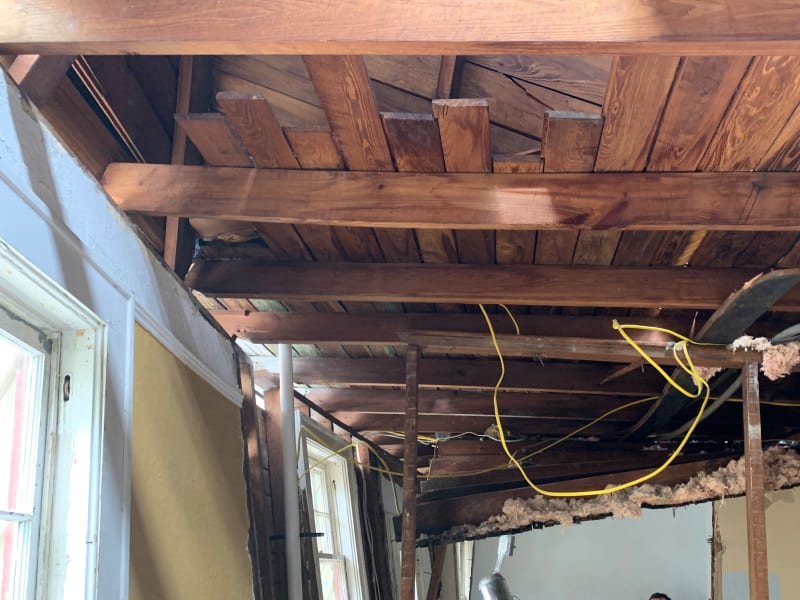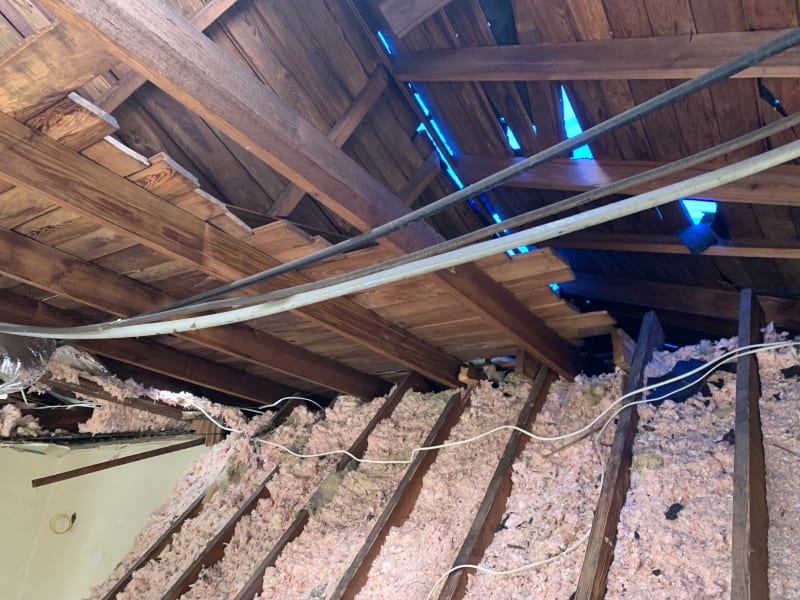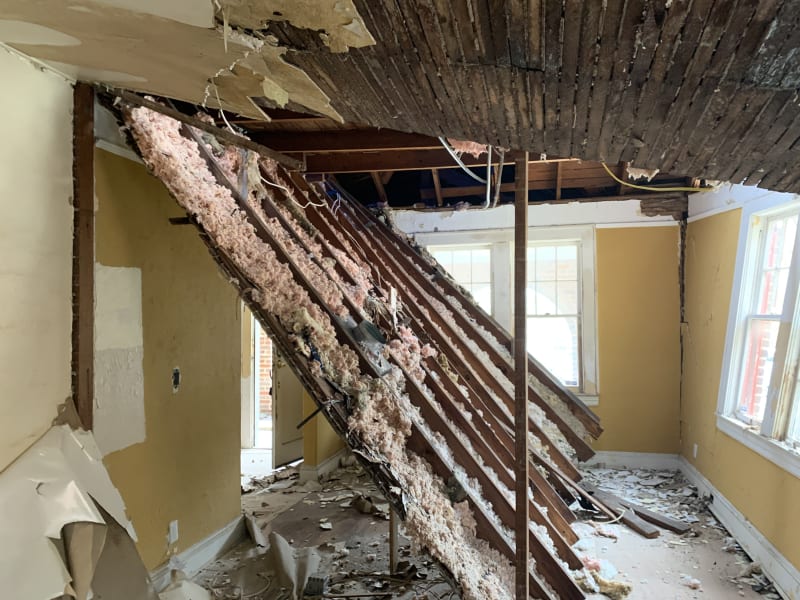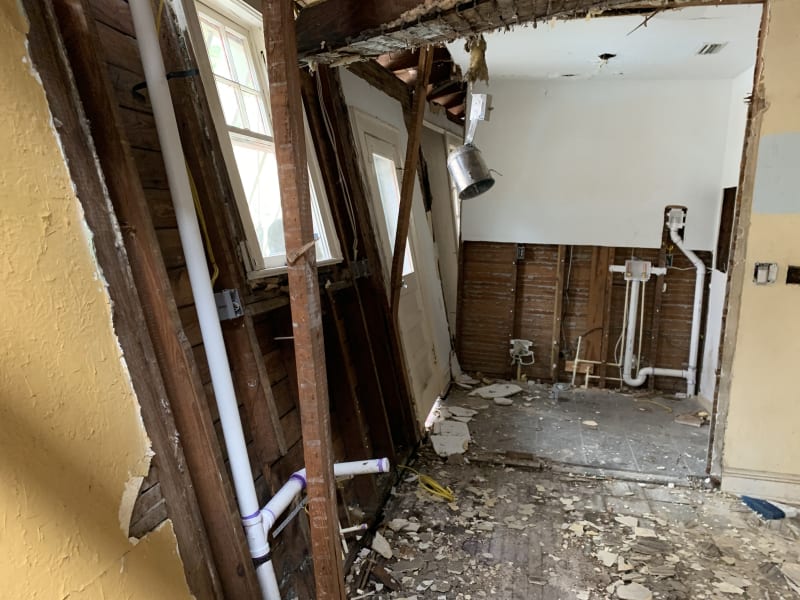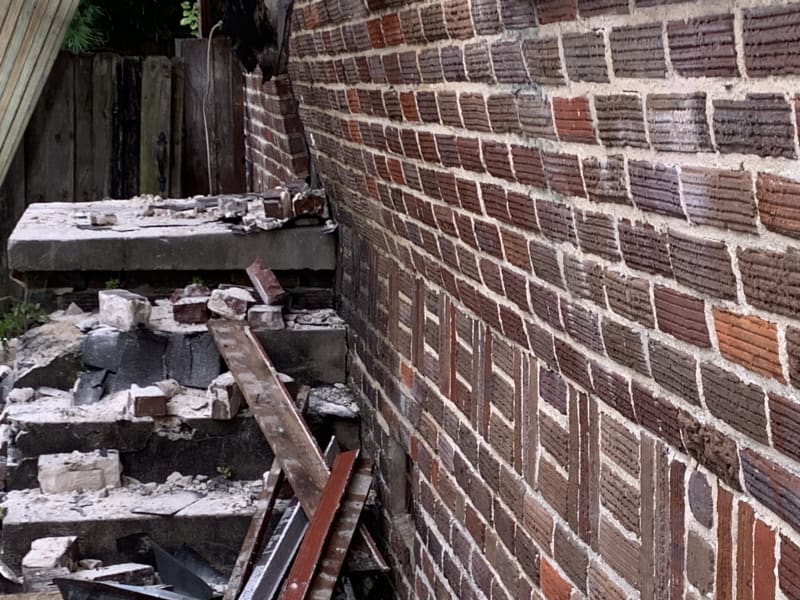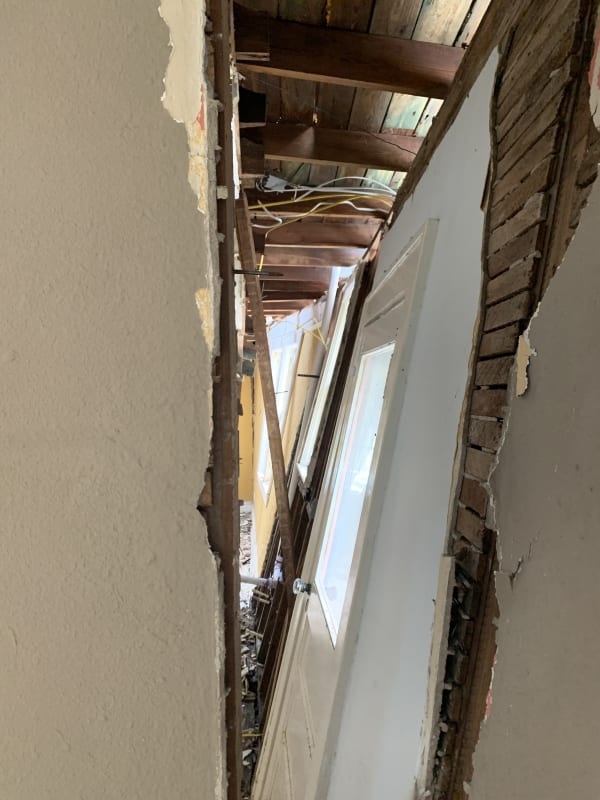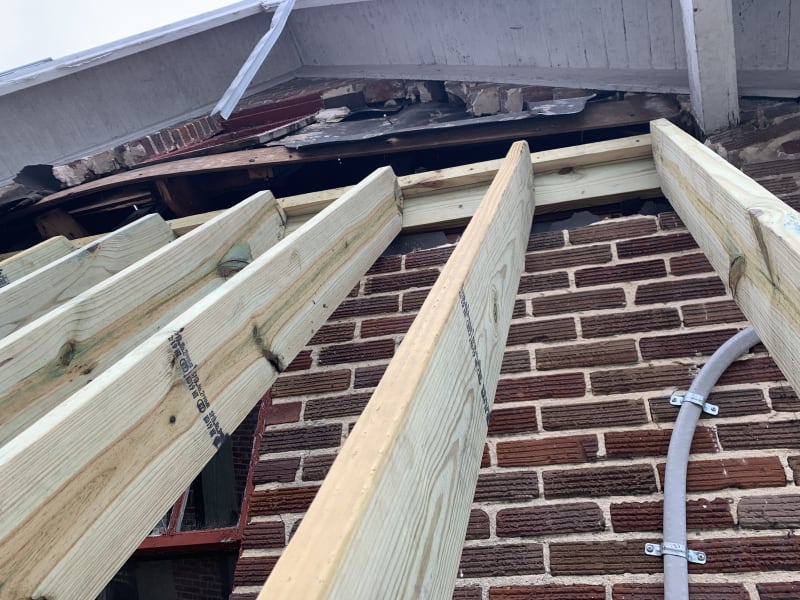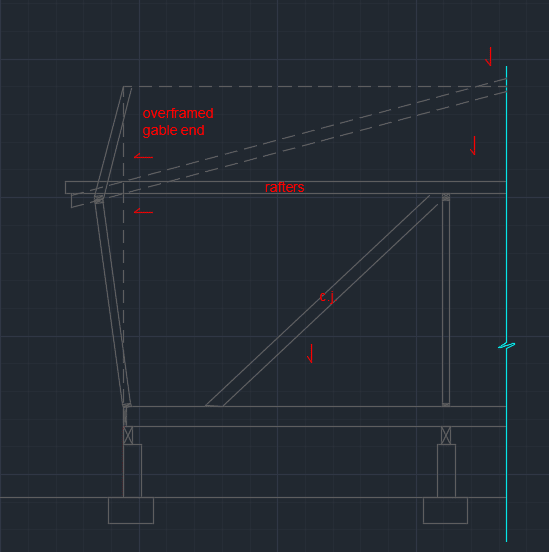An exterior wood framed wall with typical brick veneer has failed (pushed out from loading up too many shingles)and needs to be temporarily shored up. Picture attached. It looks like they at least attaching the shoring to the framing but they are using the slab on grade to prevent the studs from kicking out. Anyone seen a similar situation or have a better alternative?
Navigation
Install the app
How to install the app on iOS
Follow along with the video below to see how to install our site as a web app on your home screen.
Note: This feature may not be available in some browsers.
More options
Style variation
-
Congratulations MintJulep on being selected by the Eng-Tips community for having the most helpful posts in the forums last week. Way to Go!
You are using an out of date browser. It may not display this or other websites correctly.
You should upgrade or use an alternative browser.
You should upgrade or use an alternative browser.
Temporary Shoring of Failed Exterior Wall 1
- Thread starter kmart30
- Start date
- Status
- Not open for further replies.
- Thread starter
- #3
Yes I believe so but haven’t seen the framing. Here is another picture...
Agree with XR, that should be temporarily supported on the inside down to a solid base (the main floor framing may or may not be considered adequate enough).
Then that wall should be removed in full and replaced outright. It appears at the gable end, the ceiling joists may be running in the wrong direction, however the rest of the roof appears to have them in the correct direction to avoid this failure, but yet it still appears to have failed. Perhaps the connection between the rafters, ceiling joists and the top of wall were inadequate.
I've seen a lot of shingles stacked on a standard rafter framed roof before, and never to this day have I seen a wall kick out sideways because of it. Until now apparently.
To answer your question, will this stop the wall from pancaking flat to the ground, potentially except that it is highly dependent on the connection between the shoring wall and the existing structure. I would also be requiring a diagonal brace or two on the shoring wall instead of just the blocking. Otherwise that wall can just fold flat.
Then that wall should be removed in full and replaced outright. It appears at the gable end, the ceiling joists may be running in the wrong direction, however the rest of the roof appears to have them in the correct direction to avoid this failure, but yet it still appears to have failed. Perhaps the connection between the rafters, ceiling joists and the top of wall were inadequate.
I've seen a lot of shingles stacked on a standard rafter framed roof before, and never to this day have I seen a wall kick out sideways because of it. Until now apparently.
To answer your question, will this stop the wall from pancaking flat to the ground, potentially except that it is highly dependent on the connection between the shoring wall and the existing structure. I would also be requiring a diagonal brace or two on the shoring wall instead of just the blocking. Otherwise that wall can just fold flat.
The brace wall has such a big angle, I doubt it is pushing back very hard on the leaning wall. I have only seen stacking shingles on a roof cause a collapse one time. They stacked them on the roof when we told them they could not because the rafter bracing had not been installed yet.
My money is on a diagonal ridge/valley brace setting on the collapsed wall.
My money is on a diagonal ridge/valley brace setting on the collapsed wall.
- Thread starter
- #6
Ron, that is what I was thinking when I first saw the picture about the angle of the wall. I like your idea of the diagonal brace but I believe the ceiling caved in on the inside so it might be tough for a crew to get good access and install them safely. Going to go give it a look tomorrow and see the damage...stay tuned!
If the ceiling caved, it's starting to feel like it would be best to peel the roof off entirely and demo that wall, rebuild both from scratch.theyre essentially going 5o have to do that to a large portion of the roof to repair that wall anyway.
- Thread starter
- #9
- Thread starter
- #10
Above are some more pictures of the inside and outside. Crazy what a few bundles of shingles can do with older construction....Looks like classic spreading with the interior ceiling joists collapsed and rafters now lying horizontally on top of wall(you can see the birdsmouth on top of the wall).
The shoring on the outside is at about 65-70 degrees with 2X8's at 12" o.c. fastened with a couple deck screws at the top and bottom. There is some unsupported brick on top of the gable end that looks like it could fall any minute(dangerous...)
I think building a vertical support wall on the inside with some horizontal/diagonal braces should keep this wall from moving temporarily. Anyone have a better/safer solution here? Thoughts?
The shoring on the outside is at about 65-70 degrees with 2X8's at 12" o.c. fastened with a couple deck screws at the top and bottom. There is some unsupported brick on top of the gable end that looks like it could fall any minute(dangerous...)
I think building a vertical support wall on the inside with some horizontal/diagonal braces should keep this wall from moving temporarily. Anyone have a better/safer solution here? Thoughts?
kmart30 said:Anyone have a better/safer solution here? Thoughts?
Yep, knock it down. It won't take much effort.
EDIT: typo
- Thread starter
- #13
This is a case of which I wonder how's come not more. How many buildings with rafters and ceiling joists carry load similar to a truss, which needs a bottom chord. Many, but my guess is the roof planks or plywood also does some of the job of carrying that thrust out from the rafters, transferring the load to the end wall as a horizontal beam on its side.?
That appears to be what I call "mis-collected framing". There was no real methodology present. Based on the pictures alone, I see the following:
[ul]
[li]Rafters span opposite of 2 different sets of ceiling joists. The rafters would have loaded the wall perpendicular to the wall that leaned not the one that failed. Picture 2[/li]
[li]Looks like the upper set of the ceiling joists is nailed on the exterior wall but not the interior wall. How could the exterior wall move out but they still be attached to it while not pulling the interior wall with it. The interior wall still looks plumb in picture 3.[/li]
[li]Looks like the lower set of ceiling joists is nailed to the interior wall and not the exterior wall or exterior wall nailing was not very good. Note the ends of the lower ceiling joists are not all torn up in the 3rd pic.[/li]
[li]The white electrical wire was routed between the 2 sets of joists. Note how the wire bends up and down to match the upper joists in the 2nd pic.[/li]
[/ul]
Looks like some attachments were non-existent or very weak.
[ul]
[li]Rafters span opposite of 2 different sets of ceiling joists. The rafters would have loaded the wall perpendicular to the wall that leaned not the one that failed. Picture 2[/li]
[li]Looks like the upper set of the ceiling joists is nailed on the exterior wall but not the interior wall. How could the exterior wall move out but they still be attached to it while not pulling the interior wall with it. The interior wall still looks plumb in picture 3.[/li]
[li]Looks like the lower set of ceiling joists is nailed to the interior wall and not the exterior wall or exterior wall nailing was not very good. Note the ends of the lower ceiling joists are not all torn up in the 3rd pic.[/li]
[li]The white electrical wire was routed between the 2 sets of joists. Note how the wire bends up and down to match the upper joists in the 2nd pic.[/li]
[/ul]
Looks like some attachments were non-existent or very weak.
- Thread starter
- #16
Geez, what I thought was a 2nd set of joists is actually a 2nd set of rafters. Mis-collected for sure. CJs could not have been nailed on very good. We always nailed the CJ to the wall, then the rafter to the wall AND to the CJ. The rafter should not pull loose from the CJ, which these did.
- Thread starter
- #18
Yes I didnt really see what was going on until I took some time to review the pictures. I knew why it failed but its hard to see clearly in the field with damage everywhere. NOw the real question is who picks up the tab? The roofing contractor or the shingle supplier?
No way for the roofing guy or supplier to take any blame. If I was his witness in court I'd have a great time going over how bad the original construction was. Unless there is some insurance coverage, which I would doubt, guess who pays. Might be best to walk away from if even possible.
I hate to bring it up, but posting the pictures could well work against you should this come to legal matters. Might be best to delete this post.
I hate to bring it up, but posting the pictures could well work against you should this come to legal matters. Might be best to delete this post.
- Thread starter
- #20
Oldestguy
They called me after the fact to help determine cause and give an opinion. I was just trying to share my experience with something that is commonly overlooked in the field(thrust) to show what can happen. It was a simple re-roof that turned into damage....there was no design professional on the project just a roofing contractor, his supplier, and the owner. However I appreciate your feedback as I am sure you have seen how anyone that steps foot on a project can come under fire...getting feedback from other engineers in practice(or not) can only make us stronger and I value this forum for that.
They called me after the fact to help determine cause and give an opinion. I was just trying to share my experience with something that is commonly overlooked in the field(thrust) to show what can happen. It was a simple re-roof that turned into damage....there was no design professional on the project just a roofing contractor, his supplier, and the owner. However I appreciate your feedback as I am sure you have seen how anyone that steps foot on a project can come under fire...getting feedback from other engineers in practice(or not) can only make us stronger and I value this forum for that.
- Status
- Not open for further replies.
Similar threads
- Replies
- 2
- Views
- 581
- Replies
- 15
- Views
- 9K
- Replies
- 3
- Views
- 7K
- Locked
- Question
- Replies
- 8
- Views
- 3K
- Locked
- Question
- Replies
- 10
- Views
- 7K

